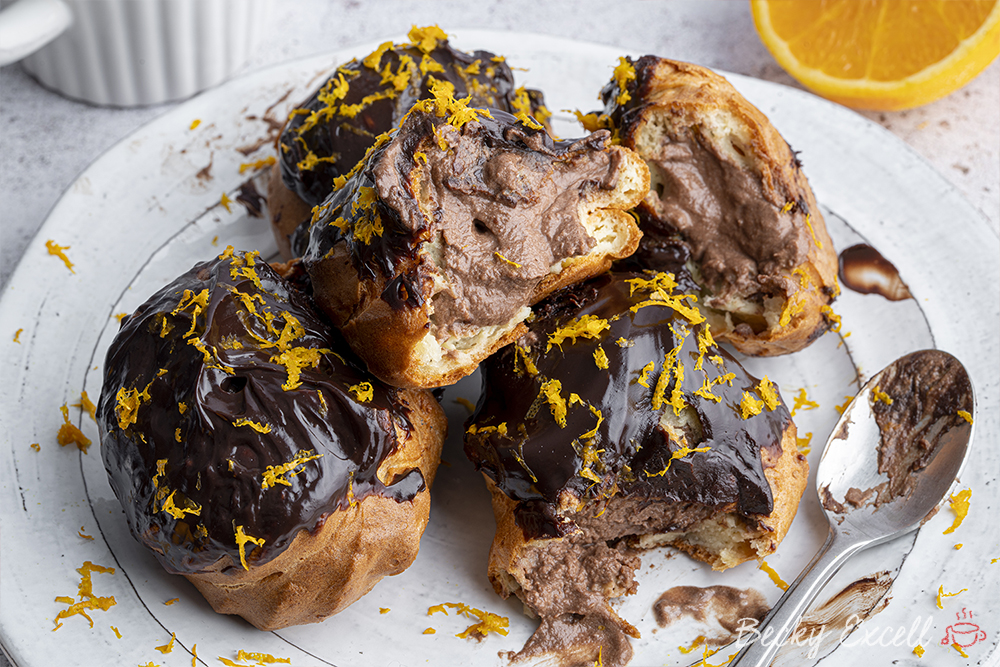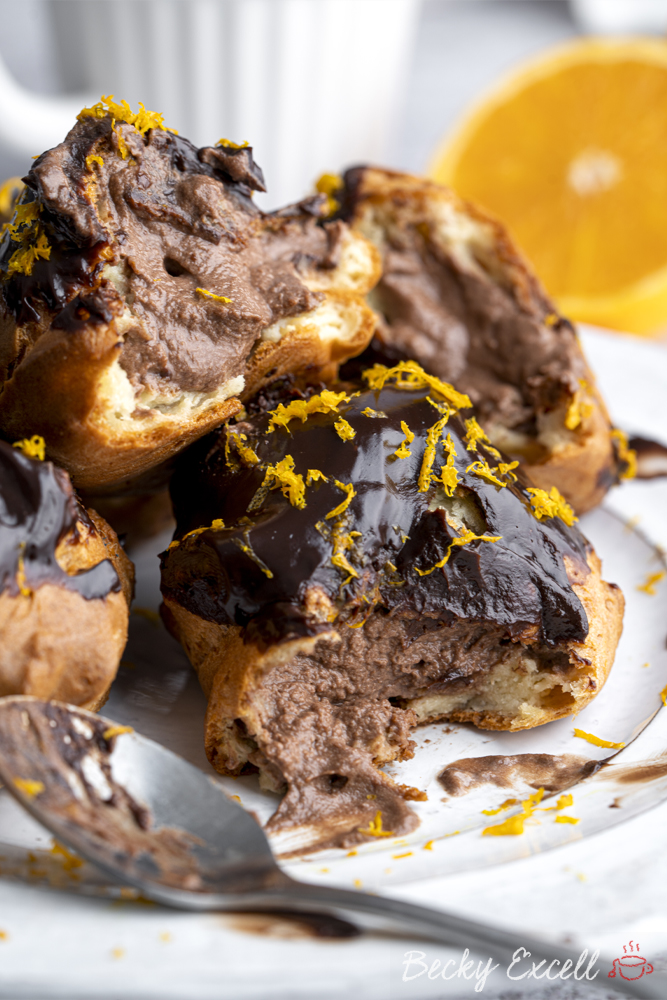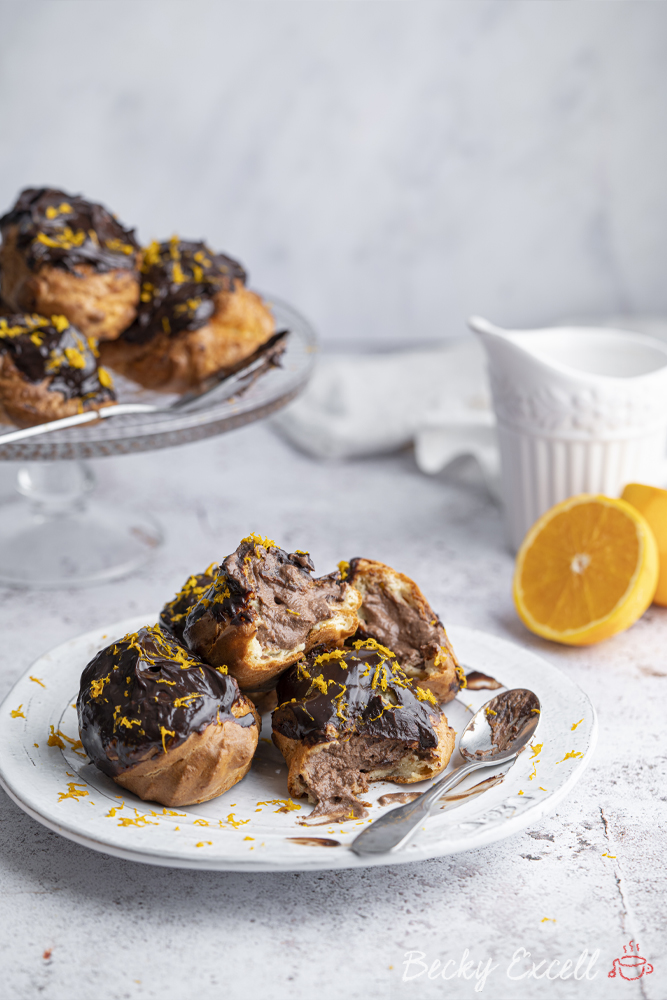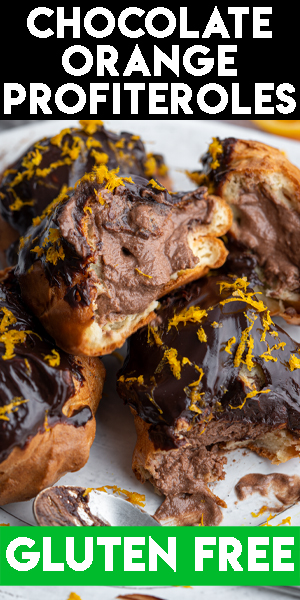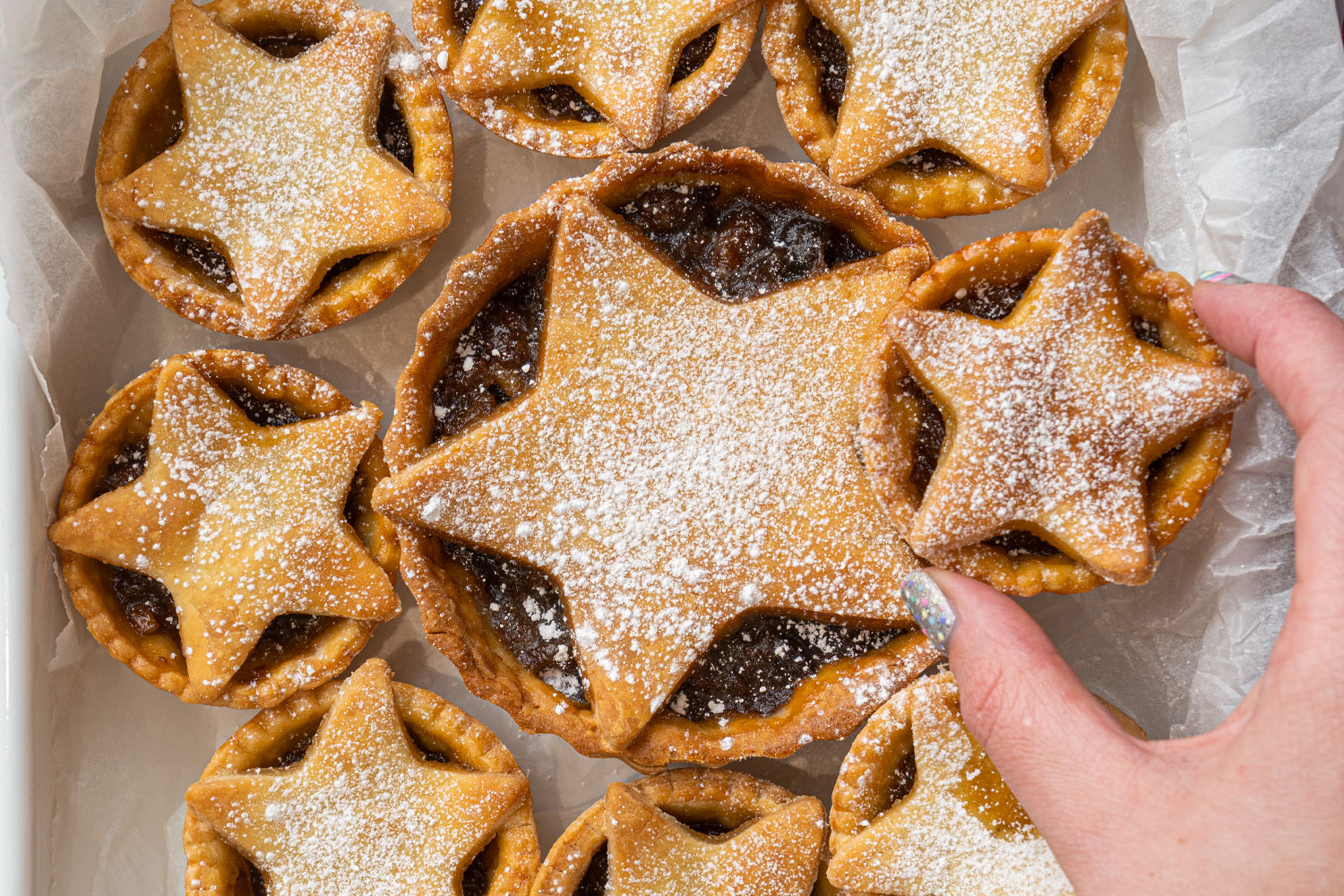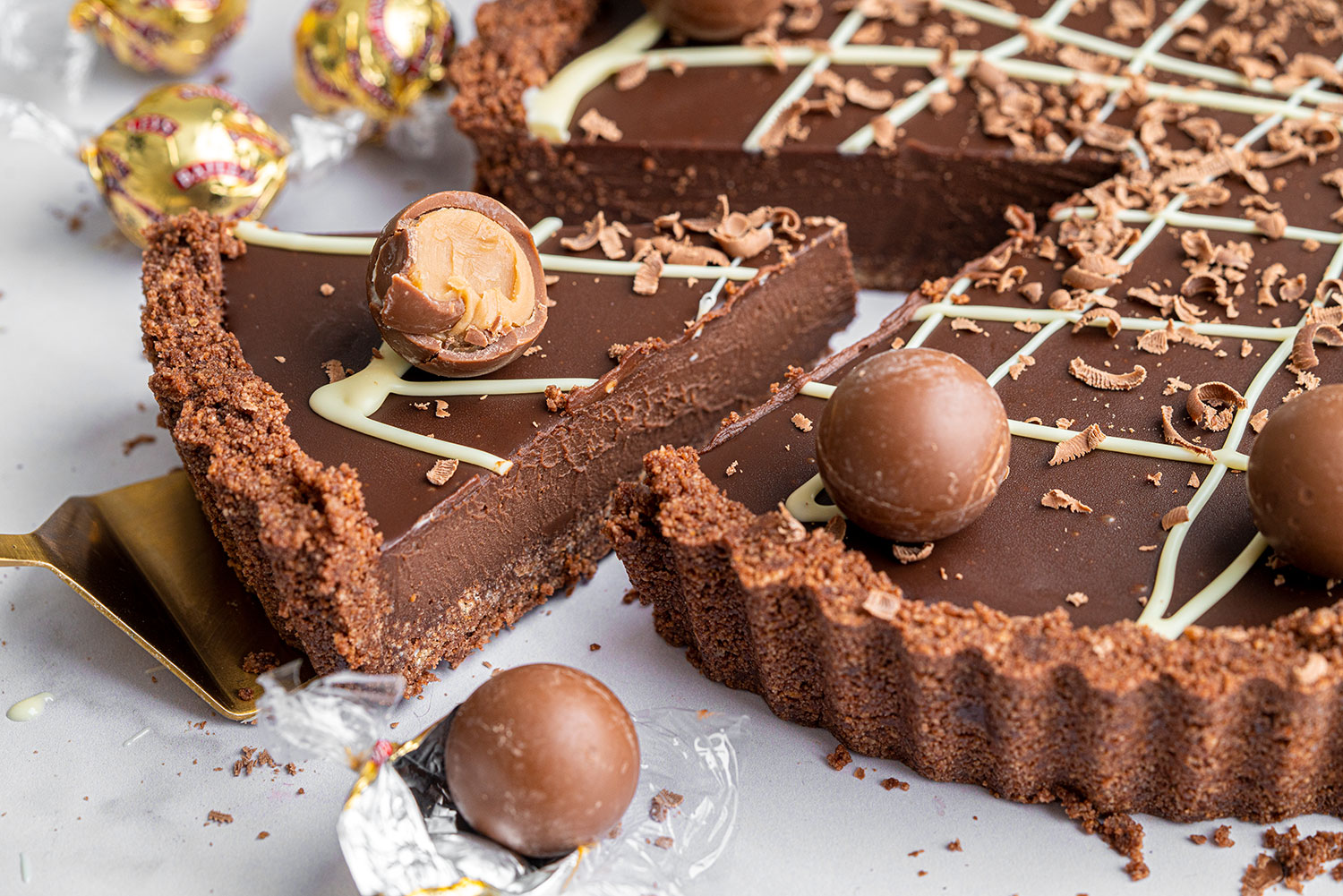Gluten-free chocolate orange profiteroles recipe, anyone? Gluten-free choux pastry is easier to make than you’d think – then all you need to do is fill them and top them. That’s it!
Gluten-free chocolate orange profiteroles recipe – the ULTIMATE, easy-to-make dessert that nobody would know is Coeliac-friendly and wheat-free too. You can even make this dairy-free using a few simple swaps!
I never realised how incredibly easy it is to make gluten-free choux pastry until I made my original gluten-free profiteroles recipe.
The method works exactly the same, the ingredients are pretty much the same (gluten-free flour and xanthan gum of course) and best of all – THEY TASTE THE SAME.
(apologies for throwing the caps lock on so early, but it needed to be said!)
Here’s a few reasons you need to make my gluten-free chocolate orange profiteroles recipe if you weren’t convinced already…
Why make my gluten-free chocolate orange profiteroles?
- You’ll learn how to make gluten-free choux pastry which is indistinguishable from muggle choux pastry.
- And once you’ve mastered that, all you need to do is fill them, top them and eat them!
- You can then use the choux pastry recipe to make eclairs too – simply pipe your dough into lines instead and follow the recipe as normal.
- That chocolate orange creamy filling, crisp choux pastry and indulgent ganache is a combo that everyone will love.
- Believe it or not, you can actually make this recipe dairy-free using a few simple swaps. See the FAQ section to find out how.
So what do my gluten-free chocolate orange profiteroles taste like?
The choux pastry is INCREDIBLY light, crisp on the outside with lots of room inside for that creamy, thick, fluffy chocolate orange filling.
Then, top with an easy two ingredient chocolate ganache, a little orange zest and you’ll wonder why you didn’t make these sooner.
Here’s everything you’ll need for this recipe, keep scrolling until you see the recipe card for the measurements and method ??
Gluten-free chocolate orange profiteroles recipe: Ingredients
For the choux pastry:
- milk
- butter
- gluten-free self raising flour
- xanthan gum
- caster sugar
- salt
- large eggs
For the filling:
- double cream
- orange extract
- cocoa powder
- icing sugar
- orange zest (optional)
For the topping:
- dark or milk chocolate
- double cream
- orange zest
So I thought I’d kick things off with a little frequently asked questions section – if you just want the recipe, then keep scrolling.
But I’ve thrown in some tips here that will be really helpful if this is your first time making this, or you want to adapt it. So here they are!
Gluten-free chocolate orange profiteroles recipe: Frequently Asked Questions
Can I make this recipe gluten-free?
It is gluten-free, though nobody would know just by tasting it – trust me!
Bear in mind that minimising cross-contamination is hugely important if you’re Coeliac or making this for someone who is. Here’s some tips from Coeliac UK on minimising the risk of cross contamination.
Also, make sure that all ingredients used don’t have any gluten-containing ingredients. Then make that that they also don’t have a ‘may contain’ warning for gluten, wheat, rye, barley, oats (which aren’t gf), spelt and khorasan wheat (aka Kamut).
Here’s some more info from Coeliac UK on identifying safe gluten-free products.
Can I make your gluten-free chocolate orange profiteroles recipe dairy free?
Yes! And it’s very easy using a few simple swaps…
- For the choux pastry, start by using Stork hard margarine instead of butter and the dairy-free milk of your choice.
- For the filling:
- Instead of using double cream, use: Elmlea Plant Double Cream (has a ‘may contain’ warning for milk and easily found in supermarkets) or if you have a milk allergy, Flora Plant Professional Double Cream (no may contain warning for milk, but can only be bought online).
- Ensure your cocoa powder is dairy-free.
- For the topping, use dairy-free chocolate and the double cream alternatives listed above. Or, simply skip the double cream all together and top with melted chocolate.
That’s it!
Can I make your gluten-free chocolate orange profiteroles recipe vegan?
Whilst it’s easy to make this recipe dairy free using the guidance above, because of the eggs in the choux pastry, it’s not so easy to make this vegan at all.
(sorry, I always try my best to make sure as many of my recipes can be made vegan, but this one was really tough)
Usually, I’d recommend you some egg replacement options here, but this recipe relies a little too much on real eggs to work. I’ve tried egg-replacers but not had much luck.
I’ll get working on a gf AND vegan choux pastry recipe and get back to you one day I hope!
Is your gluten-free chocolate orange profiteroles recipe nut-free?
Yep, this is a nut-free recipe as far as ingredients go, BUT make sure you check the ingredients label on ALL the products you use to bake this cake just to be safe.
Even if the products don’t contain nuts, they may have a ‘may contain nuts’ warning due to being produced in a factory that handles nuts.
You can never be too careful so always read the labels on everything first!
Is your gluten-free chocolate orange profiteroles recipe low FODMAP?
Unfortunately, because of the use of double cream, this recipe is NOT suitable for the elimination phase of the low FODMAP diet.
And because dairy-free alternatives tend to use high FODMAP ingredients as a replacement, those aren’t suitable either.
However, if you use lactose-free milk in the choux pastry – that would make it low FODMAP. As for the filling, you can use option 2 as the filling over in my original gluten-free profiteroles recipe and use lactose-free milk for that – then just add the orange extract and cocoa powder to it (ensuring the cocoa powder is lactose-free).
Finally, simply top with melted lactose-free chocolate instead of the ganache in this recipe. Then, you have elimination phase-safe gluten-free chocolate orange profiteroles!
Do I need any special equipment to bake your gluten free profiteroles recipe?
You’ll need some piping bags and an open nozzle – I use the 1A nozzle in this set.
Otherwise, you’re good to go.
Can I make this recipe without using piping bags and nozzles?
Technically yes, but I wouldn’t recommend it! If you’re in a pinch and you have no piping bags or nozzles, you can always put your choux pastry dough into a medium plastic sandwich bag.
Then, just snip off one of the corners using a pair of scissors so that you have a hole approximately 1cm big. It’s not ideal, but it’ll definitely do!
Try to make sure each choux pastry blob is the same size as it might be a little harder without a nozzle and proper piping bag.
And if you don’t even have a sandwich bag, spend A LOT more time spooning out nice even blobs onto a baking tray and making sure they’re all the same size. If you don’t care about how they look too much, you’ll definitely still produce something edible and tasty!
Can I make this recipe without xanthan gum?
You’ll see xanthan gum in a lot of my recipes as it’s an essential ingredient in gluten free baking. So I definitely wouldn’t recommend removing xanthan gum from any of my recipes if you can really avoid doing so!
But what if you didn’t have any to hand?
Well, this is one of those recipes where it wouldn’t be the end of the world if you didn’t include it. Why? Because there’s actually a little xanthan gum in gluten free self-raising flour to start with, which will help if you don’t have any.
But yeah – if you have it and can use tolerate it, then definitely use it!
Can I make this recipe using other gluten free flours like buckwheat flour or coconut flour?
There’s a big difference between ‘gluten free flour’ and a *singular* type gluten free flour. When I say ‘gluten free flour’, I mean a BLEND of gluten free flours, not just one singular flour.
Most gluten free flour you buy in the supermarket typically contains a blend of rice flour, potato flour, maize flour, tapioca flour AND buckwheat flour. That’s a lot of different flours!
In gluten free self-raising flour, there’s usually even a little baking powder and xanthan gum in it too.
So to replace it with just one specific type of flour… that’s not going to cut it at all. Definitely go for a gluten free flour blend.
Do I need weighing scales to make your gluten-free chocolate orange profiteroles?
In short… yes, yes and yes! And I wouldn’t advise attempting any my recipes without them.
A lot of work went into fine tuning ratios and quantities and for me, baking is all about consistency and precision. I want you to make this recipe and for it to turn out EXACTLY like mine did.
I’d recommending using digital cooking scales like these so you know you’re getting an accurate measurement and replicating my recipe as accurately as poss.
5 tips for the perfect gluten-free chocolate orange profiteroles
- Ensure your choux pastry dough isn’t too runny. It must be lovely and thick so it holds its shape when piped into a ball.
- Dab any pointy, raised bits of dough with water once piped. This will stop your choux balls becoming oddly shaped in the oven.
- Don’t open the oven until they’re done! They will massively deflate if you open the oven too early.
- Once baked, pierce a hole in the bottom of each of your choux balls and turn them upsidedown. This will stop them getting soggy as the steam escapes.
- Don’t fill your profiteroles too early. The choux pastry will lose its lovely, crisp exterior and become soggy.
How to store your gluten-free chocolate orange profiteroles
Without being filled, I’ve kept them for 2-3 days in an air-tight container with no problems – they don’t need to be kept in the fridge.
The longer you keep them, the more they’ll lose their crisp exterior. If they do go a bit soft, you can always reheat them (unfilled of course) in the oven at 200c for 5 minutes to crisp them up again.
If you’ve already put your cream filling inside, I wouldn’t keep them for longer than 24-48 hours in the fridge – they will definitely lose their crisp shell if you do so.
To freeze them:
- You can freeze your unfilled choux buns for around 2-3 months – they should then only take 1-2 hours to defrost in the fridge or 30 minutes out of the fridge. Once defrosted, consider reheating the unfilled choux buns in the oven for a few minutes to try and bring back their crisp exterior! Then proceed with the rest of the recipe.
- You can also freeze your filled choux buns for up to 2-3 months. The best way to freeze them, is spread them out on a baking tray, then once fully-frozen, you can then transfer them to an airtight container and place back in the freezer. When you want to eat them, simply allow to defrost in the fridge for 2-3 hours or an hour outside of the fridge. They’ll lose their crisp exterior by freezing them filled, but of course, they’ll taste just as good!
But all that being said, it’s best to fill your choux buns and immediately eat them to experience them at their best.
Gluten-free chocolate orange profiteroles recipe: Method
Oh and here’s a printable version of my gluten-free chocolate orange profiteroles recipe. Please remember to give it 5 stars if you tried it and enjoyed it as it helps people know it’s worth trying too! ⭐️

Gluten-free Chocolate Orange Profiteroles Recipe (dairy-free option)
Equipment
Ingredients
For the choux pastry:
- 75 ml water
- 75 ml milk or dairy-free alternative if necessary
- 50 g butter cut into pieces (or Stork hard margarine if dairy-free)
- 75 g gluten-free self raising flour
- 1/4 tsp xanthan gum
- 1 tsp caster sugar
- 1/4 tsp salt
- 2 large eggs
For the filling:
- 300 ml double cream or dairy-free alternative if necessary - linked in FAQ section
- 1 tsp orange extract
- 1 tbsp cocoa powder ensure dairy-free if necessary
- 3 tbsp icing sugar
- zest of 1 orange optional
For the ganache topping:
- 175 g dark or milk chocolate dairy-free if necessary
- 175 g double cream or dairy-free alternative if necessary - linked in FAQ section
- 1 orange for zesting
Instructions
For the choux pastry
- Preheat your oven to 220C / 200C Fan. Prepare a large baking sheet.
- Sieve your gluten free self raising flour, xanthan gum, sugar and salt into a bowl. Put to one side.
- Place your milk and water into a small/medium saucepan alongside your butter. Heat on a low/medium heat until the butter has melted.
- Once melted allow to bring up to a gentle simmer. Once simmering, turn the heat off and immediately add your flour mix to the saucepan. Mix vigorously straight away until everything comes together into a dough.
- If the mixture still seems a tiny bit moist on top put it back on a very low heat (continuously stirring) for a minute or so, don't let it stick to the bottom.
- Take off the heat and place in a bowl to cool a little. You need to do this before adding your eggs next.
- Beat 2 eggs in a jug and then gradually add it to the dough. You need to mix really thoroughly between each addition. You can do this by hand quite easily but its a proper workout! I tend to do it with an electric hand mixer on the lowest setting. It doesn't look the prettiest whilst mixing but keep going until smooth.
- Make sure you are watching the consistency of the dough as you add the egg. You don't want it to go too runny. It needs to be thick enough to be a pipeable consistency that can hold it's shape.
- At this point the dough should be ready to pipe. Transfer your dough into a piping bag (I use a 1A nozzle - linked in FAQ section). Pipe small balls onto your baking sheet with a little space between each ball.
- Once they've all been piped, wet your finger and dab the top of each ball to help with the shape. Gently flatten any pointy bits.
- You can gently brush a little egg or milk on top of each ball but only if you have some spare as it's not necessary.
- Place in the oven at 220C / 200C Fan for 10 minutes. Then reduce the temperature of the oven to 170C / 150C Fan for a further 15 minutes until puffy and golden. Never open the oven until they are ready to be taken out.
- Remove from the oven and pierce the bottom of each profiterole with a skewer and place them upside down to let the steam out, otherwise they will be soggy inside. Allow to cool down in a warm area - I usually do this by putting them back in the oven, turned off with the door ajar - do this for about 20 minutes.
- Store in an airtight container if you aren't planning to use them immediately.
For the filling:
- Add your cream into a bowl alongside orange extract, icing sugar and cocoa powder. Whisk together, ideally using an electric hand whisk until thickened and quite stiff. Then stir in your orange zest.
For the topping:
- Chop your chocolate finely and place into a bowl.
- Heat your cream until just before boiling and then pour it over the finely chopped chocolate. Allow to sit for 5 minutes and then mix together till the chocolate is fully melted and combined.
- If you want you can add a 1/2 tsp of orange extract and stir it in.
To assemble your profiteroles:
- Simply cut each choux bun in half and add your filling using a spoon OR pipe it in by placing the filling into a piping bag with a star nozzle. Either works well! They should start to feel heavier with the filling inside.
- Dip each filled bun into the ganache topping and top with some orange zest.
- Serve up straight away ideally. But you can leave them in the fridge for a couple of hours if you need to.
Nutrition
Any questions about the recipe? Please do let me know by following me on Instagram and leaving me a comment on a recent photo!
Thanks for reading,
Becky xxx
Oh and don’t forget to pin this for later!

